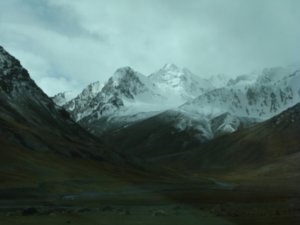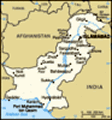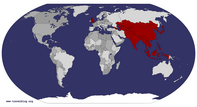Advertisement
Published: October 21st 2008

 KKH
KKH
Coming to the KunjerabThe bus to Pakistan was due to leave at 11am; which 11am was a moot point! There is a constant dilemma about times. 'Official' activities, such as bus and train times run on Beijing time, whereas most of the Kashgar population run on local time - 2 hours earlier -so it was difficult to know quite when the bus would take off, and when we should start to queue. In the event, we waited around for a couple of hours. The bus left half empty, which meant we had the unusual experience of having plenty of space. Most of the native passengers seemed to be taking a fair amount of Kashgar market with them! Cardboard boxes, tarpaulins gathered and sewn up, all containing god knows what, to sell at home for a nice profit.
The landscape was of a fertile, productive agriculture for the first hours, and as we began to climb, (we were in the Tajiki Autonomous Region of Xingjiang), the dress code, along with facial features, began to change. Tajiks are european looking, often with blue or green eyes, and the women often wear highly decorated pill-box hats. Whilst muslim, they are Ismaili and can dress freely.
The journey

 KKH
KKH
Sost border checkpoint.was broken with a stopover in Tashkurgan, a fairly grotty strip of hotels and tourist shops, and having checked in, we walked out to the only thing worth seeing - the remains of an old mud built fort. We walked back in the dusk, with very loud music and Chinese barked over a system of loudspeakers over the town. The place echoed with it, and coupled with acid green lighting and neon signs it gave the impression that it was trying to make more of itself than it merited. We found a cafe with a BBQ outside, and were able to choose the veg, meat or fish we liked to be cooked. Some looked wierd, like dog's ears and curly mushrooms, but the ones we selected were given to the woman in charge of the BBQ and they came back to the table perfectly done and delicious! As we ate, the cafe filled with chinese, who became extremely drunk and rowdy until it became impossible to hear oursleves talk!
We were woken to the sound of the PA at 6am - no wonder the chinese have taken to drink! An added bonus being that, at this altitude, 3,200m, the effect

 Hunza Valley
Hunza Valley
Cathedral Peaks Passuof alcohol was doubly strong as "we" found to our cost.........
Back on the bus, on the KKH, we began the serious ascent to the Kunjerab Pass (4,700m). The mountains to both sides grew bigger and bigger, and more snow-covered. Having passed through many checkpoints, some for passport control, others to have all luggage checked, we got to the top of the pass, the end of China, and the start of Pakistan. Up to this point, the road has been remarkably well maintained, but as soon as we crossed the border to Pakistan, the road deteriorated into a poor, pot-holed, rock strewn B-road.
The other , far more stunning change, was the scenery. It was more majestic, more raw, and certainly the most powerful landscape we have passed through. The scale, the wildness, and the sense that it's not a place for humans to be in was very exciting, as well as totally intimidating. Around every bend it seemed there was an ever more majestic sight: an even higher peak beyond the immediate mountains: an even more fragile mountainside that looked as if at any minute would collapse into the valley. That this is happening all the time is apparent

 KKH
KKH
Passu Glacieron the road. There are constant rockfalls and land slides, and there is a permanent crew of diggers and JCB's clearing them off to make the road passable. It is the most awesome place we've ever seen! At the bottom of the pass the road went through the Kunjerab National Park, home to the Snow Leopard, Grizzly Bear, Blue Sheep, and many other species, none of which we saw, of course!
Sost is the official border checkpoint, and after successfully passing all the criteria, we were in Pakistan. A delight and complete surprise for us was that the first thing anyone said to us was:'Welcome to Pakistan' and meant it. This experience was to be repeated constantly throughout our stay in Pakistan.
From Sost we stayed on the bus to Passu, a village in the Hunza region of Northern Areas. Famous for its apricots, friendliness, hospitality to strangers, and the odd tribal war! The village consists of low, mainly mud houses, joined by narrow paths and irrigation channels, and each house with it's plot of land with fruit trees and veg gardens. At the moment, everyone is busy lifting their potatoes, and everywhere are great sacks of spuds leaning against

 Passu Village
Passu Village
interior of tradional houseeach other, some to be kept and some to be sold.
On our first day there, as we walked along the road we were met by a very friendly woman who was just off to milk her cow, and she invited us back to her house.
The single storey building had a main room with a stove in the central well, both for cooking and heating. In winter this room is used as a communal bedroom, where all can benefit from the fire. Carpets, rugs and cushions are strewn, giving it a yurt-like feel, as does the skylight which lets the smoke out. The timber joists are carved, and the mud brick walls are painted white. Very few belongings are to be seen, just the necessary to eat and sleep. There were no adornments on the wall except for a photograph or two, one of which invariably being of the Aga Khan.
On one of our day treks we went out to the other side of the Hunza river, crossing a precarious looking suspension bridge. It really had all the makings for a location for "Indiana Jones". Whilst only a modest twenty to thirty feet above the river, it was

 Passu village
Passu village
another house with portable stovegreat fun and a little scary to cross the rickety contraption. Constructed with thick metal cable to form a frame, and then, almost as a gesture, a few pieces of rough timber placed every feet on which to tread.
Birdlife immediately improved. KItes, choughs, falcons and lots of songbirds were now commonly seen as were hoopoes, redstarts, and yellow wagtails. No sight of any vultures or eagles though, surprisingly, as this is very much their territory.
To get back across the river, a mile or so upstream,we had to cross another suspension bridge, reached by a very narrow path winding down a vertical cliff face. Exciting and scary again!
In every direction there were stunning views, and at night the skies were clear and full of stars. Another much longer trek took us up on to the Batura Glacier, at 65K the world's longest.
We decided to visit Karimabad, the capital of the Hunza region, so waited on the KKH outside the guest houase for the early bus. How many people can you fit in a twelve seater mini-bus? In Hunza, the record so far was 19, which included one on the roof, two hanging off the back and one

 KKH
KKH
Passu Glaciersitting on the driver's lap! This all with a serious amount of luggage, and women in their allotted front row.
Compared to Passu, Karimabad feels much bigger and buzzier altogether. It is a focal point for tourists and trekkers, and has a rich regional folk tradition (as well as a nice cappuccino) with a number of languages spoken - Shina, Wakhi, Burushaski, Pashtu and fortunately English, which is almost universally spoken.
Karimabad is on a hill, and at the top of the town, by an old fort, there is a spectacular view down the Hunza Valley, with Rakaposhi (7010m) towering above it all. It is absolutely breathtaking, as the views here so often are. It's also mesmerising watching high peaks appear and disappear in the clouds that are constantly forming and dissolving around them. We also had our first real downpour since leaving Blighty! The mountains closed right in, with land and sky intermingling in myriad shades of grey. On our way back to Passu, we were temporarily stopped due to a rally moving slowly down the road. All men and boys, chanting Islamic prayers and beating their chests vigourously in time to the chant.Though we are in a relatively

 KKH
KKH
Hunza river free and easy Ismaili area, we have the occasional reminder that we are definitely in an Islamic culture. It was in Karimabad that we first heard about the Marriott Hotel bombing in Islamabad, causing a ripple of concern amongst the travelling community, and a wish to reassure folks back home that we were safe and well. Communications were severly restricted in the Northern Areas, with frequent power cuts and very slow Internet connections, and for us, no mobile signal.
The following day we walked to Hussaini village, 8K along the KKH from Passu, then up to Borit Lake - a steep climb of about 1K from the road. It's a small lake, but beautifully situated among the mountains, giving an alpine feel. Whilst enjoying a chai at the lakeside 'hotel' we spotted several Marsh Harriers and a small robin-like song bird with a metallic royal blue band around the throat instead of a red breast. From Borit we walked back to Passu, through another prosperous village, before reaching the Passu Glacier. On the way we passed through a valley of rocks that had been eroded into all sorts of Hepworth-esque shapes, then came upon a group of amazing slate

 KKH Passu
KKH Passu
crossing the hunza riverformations which had been squeezed vertically to produce overhangs and clusters unlike anything we'd ever seen before. These shapes most closely resembled mushroom gills on a gigantic scale.
As we walked uphill towards the glacier the wind started to blow, whipping up the sand in the valley below until it formed a light mist that moved up the gorge. At the top of our climb, we could look down upon the white ridges and crevasses of the glacier stretching up the mountain sides. Another moment to reflect on the sense this land gives: violent in its impact, as if it could all come tumbling down in an instant! And, of course, sometimes it does. Having travelled up and down this part of the KKH, it looks as if humans are losing the battle to keep a functioning road in this area. There is constant work, with the assistance of civil engineers from China, but it all looks in vain. In places, water running off has washed the road away. In others, rockfall takes up half the width of the road. The drivers are undeterred, half being local minibuses etc., and the other half the wondrously decorative Pakistani lorries; folk art
in motion.
Our next move south was to Gilgit.
Advertisement
Tot: 0.106s; Tpl: 0.013s; cc: 13; qc: 56; dbt: 0.0501s; 1; m:domysql w:travelblog (10.17.0.13); sld: 1;
; mem: 1.2mb

















Diana Beale
non-member comment
hi from cobnor...
Hello John and Penny - glad to get the right blog address now and have bookmarked it for safe-keeping ...oh gosh and wow ... have just glimpsed your photos and some of your pennings ... but am off to do sheep (our ram, Victor, is grooving it with his 20 girlfriends), stuff with kids etc so will adjourn till there's a quieter moment to savour your stories ... But just to say, it's fab to get access to your adventures and it's a wide wide world (have just been listening to "from our own correspondent" too ... and what a great programme that is ...) more anon ... till then love from all the Taylor Beale gang here D xxx PS Autumn colours are stunning this year - yum